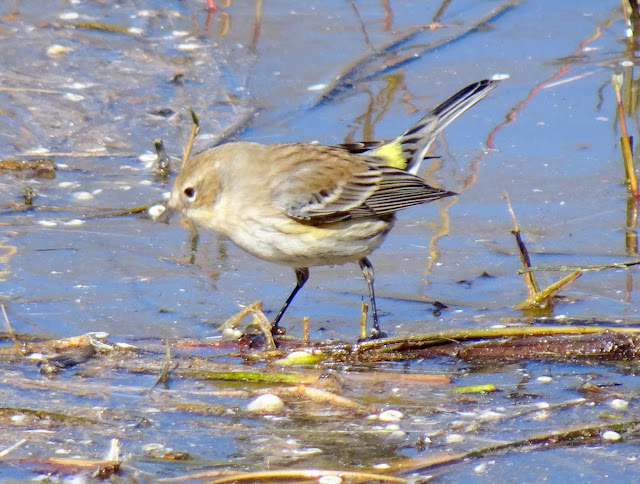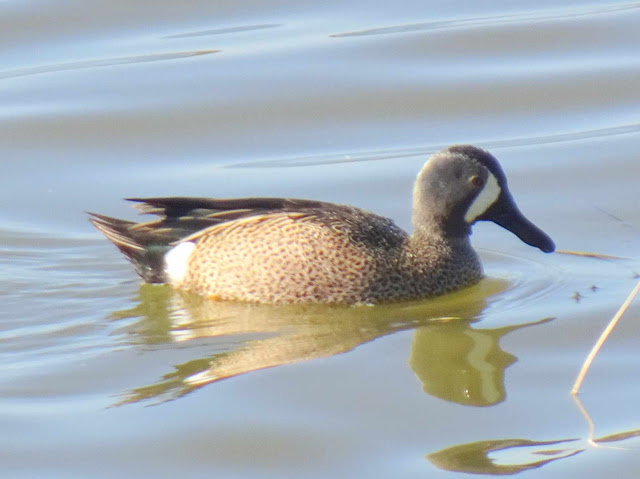Choke Canyon State Park is the last of our long list of new-to-us Texas state parks on our trip down south. This is our seventh new Texas State Park this year! This is a particularly remote park, so we assumed we would have no problems getting a camping site in January. We were surprised to find only two openings during the week, and nothing available this weekend. What?!? We reserved a three-night stay during the week. As we pulled into the park, the ranger handed us our vehicle passes and asked, "So you're here for the bird I guess?"
We obviously had no idea what she was talking about, so she had to educate us. The Spotted Rail is a water bird that normally lives in Central and South America. But for some reason, a single bird has flown too far north and has taken up residence at Choke Canyon State Park. Birders from all over are flocking into the park in hopes of a glimpse of this rare bird. That explains the full campground!
We got information from serious birders we met in the campground, and we googled pictures of the Spotted Rail. Now we know where and how to look for this rare bird. So even though we didn't even know this bird existed 24 hours ago, we are now on a mission to find it. We took off on a hike toward the last sighting, and got exercise on the way. As we walked by the lake marina, we had to chuckle at this heron, waiting patiently for scraps at the deserted fish cleaning station.
But the Spotted Rail hasn't been hanging out at the big lake at this state park. He's taken up residence at the smaller "75 acre lake" that is about a mile and a half from our campground. Denisa is easily distracted from our mission, and she kept stopping to take pictures of the dainty vermillion flycatchers in the trees close to the lake.
These are flashy red birds, and to novice bird-watchers like us they were the find of the day.
When we asked the ranger about kayaking, we were warned that there are alligators at Choke Canyon.
That sign just gave Denisa another reason to try to snap another picture of that vermillion flycatcher, dining on a bug he had just caught.
When we got to the smaller lake, we knew we were in the right place when we saw the long line of people with big cameras. There were around 15 people staring at the edge of the water.
Caution tape was laid out in the grass, warning birders not to get any closer to the area where the Spotted Rail had taken up residence. The last sighting--just 30 minutes before we arrived--was when the bird flew from the green reeds at the edge of the lake on the left, to the clump of green reeds on the right. So we stood and watched and waited . . .
Then we sat in the grass, staring at that clump of reeds. Whew! This bird watching is tough work.
One of the bird experts said that the Spotted Rail usually rests in the afternoon, so he might not be out for a while. So we decided to take a walk around the lake. Many birds have come south to avoid the cold weather up north, so we had plenty to keep us occupied.
We like to call this the "candy-corn-nose-bird" because of his brightly colored beak. But it's more common name is the common gallinule. We were glad that this bird is so friendly and comes close to the water's edge for a picture--and doesn't need to rest in the afternoon.
There are plenty of birds that vacation here just for the winter. Since we're certainly not bird experts, we have no idea which are the vacationers and which are the locals. We only know that the bird below is a white ibis because we heard the real birders talking about it.
We're not sure what this rather plain-looking little bird is, but Denisa loved the way the camera kept him clear and blurred the background behind him.
Being on a lake meant that we got good looks at the ducks that came close to the water's edge.
We saw the ebony and ivory combinations of the black-legged great egret hanging out with the white-beaked black-feathered coot.
Even though we are novice birders we think that this is a great egret, with his black legs and toes and a huge wing span when he flies.
A very similar-looking snowy egret, has a smaller wing span, and brilliant yellow toes. He wiggles those brightly-colored toes when he is standing in the shallow water fishing. When a fish thinks he is going to nibble on a tasty bright yellow worm, the egret nibbles on that fish.
We've waited a couple hours now for the Spotted Rail to finish his afternoon nap, and we're back at the water's edge. Several of the experienced birders are taking pictures of this Sora Rail on the edge of the water. This is a cousin to the bird on our mission today, and we're told that normally this would be a great find.
We went for another walk close to the lake, where we see a crested caracara falcon perched in its hunting pose on top of a dead tree branch.
Since we've been watching for the resident fauna today, we should report that we also found some interesting flora. These are unusual flowering succulents.
Hiding among the prickly pear cactus, these tall red blooms were a fun find on a day when we weren't having any luck with our mission of finding that silly spotted rail. After some very detailed googling, Mark finally found that this plant has several names--Mother of Thousands, Alligator Plant, Mexican Hat. Too bad we weren't on a mission to find this interesting plant today.
We also found some huge fish carcasses on this less-traveled side of the lake. Mark stepped into the picture just to give scale to that large fish body.
This is also where we found our first wild javelina. These guys have very poor eye sight, and we certainly saw him before he knew we were around. In fact, he kept walking right toward us, and we had to make some commotion to let him know we were watching him.
As we walked around the lake, we used our binoculars not just for bird-watching, but for people watching. We've been hanging around the area for four hours now, and the group of birders staring at the reeds has thinned some. But with our binoculars we can watch them even from this distance. If we see them perk up and start snapping pictures, we can race to the other side of the lake in a hurry to complete our mission and see the Spotted Rail.
With those binoculars pointed heaven-ward, we spotted this flock of sand hill cranes flying in formation.
We didn't see any excitement among the birders on the shore, and we began to feel sorry for those that made a long drive to see the Spotted Rail today. We'll be here for three nights, so we still have more opportunities for this bird sighting. So we continued our walk, enjoying the beautiful weather that we have been blessed with for our hours spent outside. It's then that we began to think that perhaps spotting a javelina wasn't a rare thing.
We spotted several more, grazing their way across the grass. These are actually collared peccaries, and that slanted white collared stripe shows up nicely in a side view photo.
We are determined in our mission to spot the rare Spotted Rail, but we have eaten all our snacks by now and Denisa is getting hangry. But we don't want to miss getting our photo of this rare bird. So Mark leaves Denisa in charge of the camera while he walks the 1.7 miles back to the campground to get the pickup and more substantial snacks. While he was gone, Denisa took some more bird pictures, but the Spotted Rail didn't show up.
We are obviously very determined to complete our mission, but the sun was sinking so low in the sky that we recognized the lighting would be terrible even if the Spotted Rail decided to show himself now. So we used the opportunity to watch the sunset over the lake, knowing that we were only a short drive from our motor home for the night.
So we didn't complete our mission of finding the rare Spotted Rail today. But we enjoyed another day of nature, wandering with many more of God's feathered wonders. We're glad that we wander slowly, and that means we have another day to accomplish our mission tomorrow!






























































